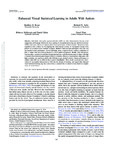Enhanced visual statistical learning in adults with autism.
| dc.contributor.author | Roser, ME | |
| dc.contributor.author | Aslin, RN | |
| dc.contributor.author | mckenzie or stancer, rebecca | |
| dc.contributor.author | Zahra, Daniel | |
| dc.contributor.author | Fiser, J | |
| dc.date.accessioned | 2019-07-12T14:35:05Z | |
| dc.date.available | 2019-07-12T14:35:05Z | |
| dc.date.issued | 2015-03 | |
| dc.identifier.issn | 0894-4105 | |
| dc.identifier.issn | 1931-1559 | |
| dc.identifier.uri | http://hdl.handle.net/10026.1/14631 | |
| dc.description.abstract |
OBJECTIVE: Individuals with autism spectrum disorder (ASD) are often characterized as having social engagement and language deficiencies, but a sparing of visuospatial processing and short-term memory (STM), with some evidence of supranormal levels of performance in these domains. The present study expanded on this evidence by investigating the observational learning of visuospatial concepts from patterns of covariation across multiple exemplars. METHOD: Child and adult participants with ASD, and age-matched control participants, viewed multishape arrays composed from a random combination of pairs of shapes that were each positioned in a fixed spatial arrangement. RESULTS: After this passive exposure phase, a posttest revealed that all participant groups could discriminate pairs of shapes with high covariation from randomly paired shapes with low covariation. Moreover, learning these shape-pairs with high covariation was superior in adults with ASD than in age-matched controls, whereas performance in children with ASD was no different than controls. CONCLUSIONS: These results extend previous observations of visuospatial enhancement in ASD into the domain of learning, and suggest that enhanced visual statistical learning may have arisen from a sustained bias to attend to local details in complex arrays of visual features. | |
| dc.format.extent | 163-172 | |
| dc.format.medium | Print-Electronic | |
| dc.language | en | |
| dc.language.iso | eng | |
| dc.publisher | American Psychological Association (APA) | |
| dc.subject | Autism Spectrum Disorder | |
| dc.subject | Asperger's | |
| dc.subject | statistical learning | |
| dc.subject | visual features | |
| dc.title | Enhanced visual statistical learning in adults with autism. | |
| dc.type | journal-article | |
| dc.type | Journal Article | |
| dc.type | Research Support, N.I.H., Extramural | |
| dc.type | Research Support, Non-U.S. Gov't | |
| plymouth.author-url | https://www.webofscience.com/api/gateway?GWVersion=2&SrcApp=PARTNER_APP&SrcAuth=LinksAMR&KeyUT=WOS:000350557700001&DestLinkType=FullRecord&DestApp=ALL_WOS&UsrCustomerID=11bb513d99f797142bcfeffcc58ea008 | |
| plymouth.issue | 2 | |
| plymouth.volume | 29 | |
| plymouth.publication-status | Published online | |
| plymouth.journal | Neuropsychology | |
| dc.identifier.doi | 10.1037/neu0000137 | |
| plymouth.organisational-group | /Plymouth | |
| plymouth.organisational-group | /Plymouth/Faculty of Arts, Humanities and Business | |
| plymouth.organisational-group | /Plymouth/Faculty of Arts, Humanities and Business/Plymouth Institute of Education | |
| plymouth.organisational-group | /Plymouth/Faculty of Health | |
| plymouth.organisational-group | /Plymouth/Faculty of Health/Peninsula Medical School | |
| plymouth.organisational-group | /Plymouth/Faculty of Health/School of Psychology | |
| plymouth.organisational-group | /Plymouth/REF 2021 Researchers by UoA | |
| plymouth.organisational-group | /Plymouth/REF 2021 Researchers by UoA/UoA04 Psychology, Psychiatry and Neuroscience | |
| plymouth.organisational-group | /Plymouth/REF 2021 Researchers by UoA/UoA23 Education | |
| plymouth.organisational-group | /Plymouth/Research Groups | |
| plymouth.organisational-group | /Plymouth/Research Groups/Centre for Brain, Cognition and Behaviour (CBCB) | |
| plymouth.organisational-group | /Plymouth/Research Groups/Centre for Brain, Cognition and Behaviour (CBCB)/Brain | |
| plymouth.organisational-group | /Plymouth/Research Groups/Plymouth Institute of Health and Care Research (PIHR) | |
| plymouth.organisational-group | /Plymouth/Users by role | |
| plymouth.organisational-group | /Plymouth/Users by role/Academics | |
| dc.publisher.place | United States | |
| dc.identifier.eissn | 1931-1559 | |
| dc.rights.embargoperiod | Not known | |
| rioxxterms.versionofrecord | 10.1037/neu0000137 | |
| rioxxterms.licenseref.uri | http://www.rioxx.net/licenses/all-rights-reserved | |
| rioxxterms.type | Journal Article/Review |


